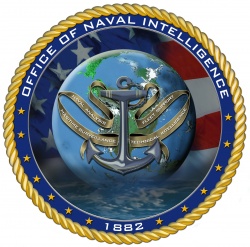Office of Naval Intelligence
 | |
| Formation | March 23, 1882 |
| Founder | |
| Parent organization | US/Navy |
| Headquarters | National Maritime Intelligence Center, Maryland |
| Leader | Director of Naval Intelligence |
| Type | |
| Interest of | National Underwater Reconnaissance Office |
| Member of | United States Intelligence Community |
| Long established US intelligence agency targeted on 9-11 | |
The Office of Naval Intelligence (ONI) is the military intelligence agency of the United States Navy.
Since the First World War, ONI's mission has broadened to include real-time reporting on the developments and activities of foreign navies; protecting maritime resources and interests; monitoring and countering transnational maritime threats - including spying on dissidents; providing technical, operational, and tactical support to the U.S. Navy and its partners; and surveying the global maritime environment. US Naval Intelligence has also been tied to coup d'etats. ONI employs over 3,000 military and civilian personnel worldwide.
Contents
Founding
ONI was founded by the Secretary of the Navy, William H. Hunt with General Order 292, which read:
An “Office of Intelligence” is hereby established in the Bureau of Navigation for the purpose of collecting and recording such naval information as may be useful to the Department in time of war, as well as in peace.
To facilitate this work, the Department Library will be combined with the “Office of Intelligence,” and placed under the direction of the Chief of the Bureau of Navigation.
Commanding and all other officers are directed to avail themselves of all opportunities which may arise to collect and to forward to the “Office of Intelligence” professional matters likely to serve the object in view.[1]
Organized crime
During World War II, the Office of Naval Intelligence struck a secret deal with the imprisoned mafia boss Charles "Lucky" Luciano. The Navy, the State of New York and Luciano reached a deal: in exchange for a commutation of his sentence, Luciano promised the complete assistance of his organization in providing intelligence to the Navy.[2]
9/11 Attack
Noting that the plane that hit the pentagon made a very difficult 330 degree corkscrew turn before hitting the pentagon to crash into the ONI, E. P. Heidner concludes that "the Office of Naval Intelligence in the Pentagon, which sustained a direct hit that day, was without a doubt, a target that was pinpointed for destruction".
Mark Gorton notes that the ONI was "investigating a gold price fixing/gold laundering scheme that could have implicated the Bush Syndicate. Also killed in the Pentagon on 9/11 were a large number of budget analysts and accountants who may have been looking into the $2.3 trillion of unaccounted military spending that Donald Rumsfeld announced on Sept 10th, 2001."[3] E. P. Heidner suggests that the ONI may have been targetted as a way of keeping them quiet about Project Monarch.[4]
National Underwater Reconnaissance Office
The highly secretive National Underwater Reconnaissance Office seems to be a division of the Office of Naval Intelligence.[5]
- Full article: National Underwater Reconnaissance Office
- Full article: National Underwater Reconnaissance Office
Surveillance
- Full article: Gene Viernes
- Full article: Gene Viernes
In the aftermath of the assassination of Gene Viernes and Silme Domingo, two trade unionist who were gunned down in Alaska in 1981, it was discovered that Naval Intelligence, with interests in the Philippines because of the naval base there, had amassed a thick dossier that included information about the two organizers’ movements. The dossier included photos of the insides of one of their apartments, descriptions of their travels to the Philippines and who they met with.
Task Force 157
In 1966, the US Navy established a covert unit known as Task Force 157. Much less known than the CIA, it might have been involved in the 1975 coup against Gough Whitlam, the then Labor Prime Minister of Australia[6]
Employee on Wikispooks
| Employee |
|---|
| Bob Woodward |
References
- ↑ General Order No. 292. History.navy.mil (2012-08-22). Retrieved on 2013-08-16.
- ↑ https://books.google.com/books?id=X-d71WDyABcC&q=luciano+prison&pg=PA107
- ↑ Document:Fifty_Years_of_the_Deep_State
- ↑ Document:Collateral Damage 911, E.P. Heidner
- ↑ https://www.washingtonpost.com/local/obituaries/stanley-r-mccord-retired-navy-officer/2012/01/19/gIQAqgUdEQ_story.html
- ↑ Brian Tohey; Secret:The Making of Australia's Security State p 175
- Packard, Wyman H. (1996). Century of U.S. Naval Intelligence. Naval Historical Center